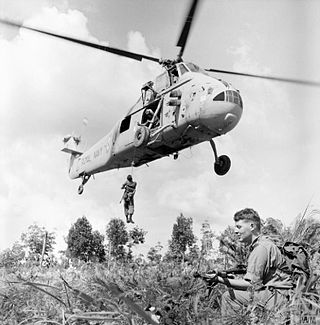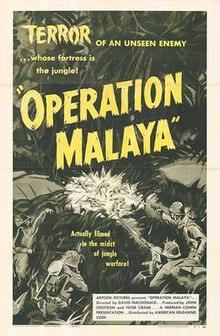
The Malayan Emergency(1948–1960) was a guerrilla war fought in British Malaya between communist fighters of the Malayan National Liberation Army (MNLA) and the military forces of the Federation of Malaya, British Empire and Commonwealth. The communists fought to win independence for Malaya from the British Empire and to establish a communist state, while the Malayan Federation and Commonwealth forces fought to combat communism and protect British economic and colonial interests. The term "Emergency" was used by the British to characterise the conflict in order to avoid referring to it as a war, because London-based insurers would not pay out in instances of civil wars. The MNLA referred to the conflict as the Anti-British National Liberation War.

The Indonesia–Malaysia confrontation or Borneo confrontation was an armed conflict from 1963 to 1966 that stemmed from Indonesia's opposition to the creation of the state of Malaysia from the Federation of Malaya. After Indonesian president Sukarno was deposed in 1966, the dispute ended peacefully.

The Batang Kali massacre was the killing of 24 unarmed male civilians in Batang Kali by the British Army's Scots Guards on 12 December 1948. The massacre took place in Batang Kali, Malaya during the Malayan Emergency, a communist insurgency involving the British Commonwealth and communist guerrillas belonging to the Malayan National Liberation Army (MNLA). British author Christopher Hale described the massacre as "Britain's My Lai" in his book titled Massacre in Malaya: Exposing Britain's My Lai.

Chin Peng, born Ong Boon Hua,

The Malayan Communist Party (MCP), officially the Communist Party of Malaya (CPM), was a Marxist–Leninist and anti-imperialist communist party which was active in British Malaya and later, the modern states of Malaysia and Singapore from 1930 to 1989. It was responsible for the creation of both the Malayan Peoples' Anti-Japanese Army and the Malayan National Liberation Army.

Sir Edward James Gent was the first appointed Governor of the Malayan Union in 1946. He was most famous for heading early British attempts to crush a pro-independence uprising in Malaya led by the Malayan Communist Party during the Malayan Emergency, before dying during the first year of the war in an aviation accident.
This article lists important figures and events in Malayan public affairs during the year 1948, together with births and deaths of significant Malayans. Malaya left the British colonial Malayan Union; the Federation of Malaya took place on 1 February.

Karak is a small town in Bentong District, Pahang, Malaysia. Located at the foothills of Malaysia's Titiwangsa Mountain Range, it is well known as a rest town along the Federal Route 2 from Kuala Lumpur to Kuantan and lends its name to the Karak Highway, or the Kuala Lumpur-Karak Expressway linking it to the country's capital of Kuala Lumpur.

The Senoi Praaq is a unit of the Royal Malaysia Police made up almost entirely of the tribal people of Peninsular Malaysia known as the Orang Asli (aborigines). The name Senoi Praaq means war people or those who fight in the Semai language. Roy Davis Linville Jumper considered them one of the finest jungle fighting forces and was highly successful in diminishing the threat by communist forces during the Malayan Emergency.

The Desert Rats is a 1953 American black-and-white war film from 20th Century Fox, produced by Robert L. Jacks, directed by Robert Wise, that stars Richard Burton, James Mason, and Robert Newton. The film's storyline concerns the Siege of Tobruk in 1941 North Africa during World War II.

The Malayan National Liberation Army (MNLA), often mistranslated as the Tentera Pembebasan Kebangsaan Malaya, was a communist guerrilla army that fought for Malayan independence from the British Empire during the Malayan Emergency (1948–1960) and later fought against the Malaysian government in the Communist insurgency in Malaysia (1968–1989). Their central committee was a trade union activist known as Chin Peng who had previously been awarded an OBE by the British for waging a guerrilla war against the Japanese occupation of Malaya. Many MNLA fighters were former members of the Malayan Peoples' Anti-Japanese Army (MPAJA) which had been previously trained and funded by the British to fight against Japan during the Second World War.

Malacca was a British Crown colony from 1946 to 1957. It came under British sovereignty after the signing of the Anglo-Dutch Treaty of 1824, and had been part of the Straits Settlements until 1946.

The British Military Administration (BMA) was the interim administrator of British Malaya from August 1945, the end of World War II, to the establishment of the Malayan Union in April 1946. The BMA was under the direct command of the Supreme Allied Commander South East Asia, Lord Louis Mountbatten. The administration had the dual function of maintaining basic subsistence during the period of reoccupation, and also of imposing the state structure upon which post-war imperial power would rest.

Malaysia's armed forces, which encompasses three major branches, originate from the formation of local military forces in the first half of the 20th century, during British colonial rule of Malaya and Singapore prior to Malaya's independence in 1957. The branches have undergone several restructuring, but fundamentally includes the army, navy and air force.

The Baling Talks were held in northern Malaya on 28 and 29 December 1955 in an attempt to resolve the Malayan Emergency situation.

The General Operations Force is the light infantry arm of the Royal Malaysia Police. The General Operations Force was established in 1948 during the Malayan Emergency by the British Administration when Malaya was a colony. The police service was mobilised to the field role, primarily to engaging Communist guerrillas during the emerging Insurgency. When Malaysia was formed in 1963, this law enforcement unit was then known as the Police Field Force. The title was adopted when it dropped the previous handle widely referred to as the Jungle Squad.
The Special Operations Volunteer Force was a special program developed by the British and Malayan authorities during the Malayan Emergency. The unit existed from 1952 until the end of the Emergency in 1960.
Ferret Force was a counter-insurgency unit formed by the British and Malayan authorities as part of their response to the communist insurgency during the Malayan Emergency. The unit only existed for six months, but was to help establish doctrine for British operations in the jungle.

The Malayan Peoples' Anti-Japanese Army (MPAJA) was a communist guerrilla army that resisted the Japanese occupation of Malaya from 1941 to 1945 in World War II. Composed mainly of ethnic Chinese guerrilla fighters, the MPAJA was the largest anti-Japanese resistance group in Malaya. Founded during the Japanese invasion of Malaya, the MPAJA was conceived as a part of a combined effort by the Malayan Communist Party (MCP) and the British colonial government, alongside various smaller groups to resist the Japanese occupation. Although the MPAJA and the MCP were officially different organisations, many saw the MPAJA as a de facto armed wing of the MCP due to its leadership being staffed by mostly ethnic Chinese communists. Many of the ex-guerrillas of the MPAJA would later form the Malayan National Liberation Army (MNLA) and resist a return to pre-war the normality of British rule of Malaya during the Malayan Emergency (1948–1960).

Southern Rhodesia, then a self-governing colony of the United Kingdom, sent two military units to fight with the Commonwealth armed forces in the Malayan Emergency of 1948–60, which pitted the Commonwealth against the Malayan National Liberation Army (MNLA), the military arm of the Malayan Communist Party. For two years, starting in March 1951, white Southern Rhodesian volunteers made up "C" Squadron of the Special Air Service (SAS). The Rhodesian African Rifles, in which black rank-and-filers and warrant officers were led by white officers, then served in Malaya from 1956 to 1958.

















